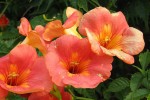 The trumpetvine that grew on a fence and tree on the property line of our Annapolis home always attracted a lot of hummingbirds when it bloomed but the head gardener always called it a weed and I viewed it with a degree of disdain. I have to admit that while it had its good points, it appeared to be a bit of a thug and soon overwhelmed the trees nearby. Looking back, I don’t know if it was American trumpetvine or Chinese trumpetvine but I suspect the latter. Both are vigorous vines that climb by twining and aerial roots. Chinese trumpetvine, however, is the more desirable species mainly because of its less rambunctious nature and its flowering characteristics. The tubular flowers flare out at the ends and are borne in loosely so that the over all display is more impressive and beautiful than that of American trumpetvine. Alas, it is not hardy beyond zone 7 so if you want trumpet vine and live in a colder region you might have to grow the American species or one of the hybrids that are more cold tolerant than the Chinese species.
The trumpetvine that grew on a fence and tree on the property line of our Annapolis home always attracted a lot of hummingbirds when it bloomed but the head gardener always called it a weed and I viewed it with a degree of disdain. I have to admit that while it had its good points, it appeared to be a bit of a thug and soon overwhelmed the trees nearby. Looking back, I don’t know if it was American trumpetvine or Chinese trumpetvine but I suspect the latter. Both are vigorous vines that climb by twining and aerial roots. Chinese trumpetvine, however, is the more desirable species mainly because of its less rambunctious nature and its flowering characteristics. The tubular flowers flare out at the ends and are borne in loosely so that the over all display is more impressive and beautiful than that of American trumpetvine. Alas, it is not hardy beyond zone 7 so if you want trumpet vine and live in a colder region you might have to grow the American species or one of the hybrids that are more cold tolerant than the Chinese species.
Type: Deciduous vine.
Bloom: Red to orange-pink funnel-shaped 3” flowers borne in loose clusters in summer.
Foliage: Large pinnately compound mid to dark green leaves with serrate margins and coarse texture.
Size: 20′-30′ H.
Light: Full to part sun but flowering better in full sun.
Soil: Well-drained soil; drought tolerant once established.
Fertilizer: Bloom booster in March; too much nitrogen will lead to excessive vegetative growth and less flowers.
Hardiness: Zones 7-9.
Care: Provide a sturdy support and help the vines get started climbing by tying to support. Flowers are borne on new growth so prune immediately after flowering. Rambunctious plants can be pruned severely in early March.
Pests and Diseases: Susceptible to powdery mildew, leaf spot, scale insects, mealy bugs, and whiteflies.
Propagation: Stem cuttings from juvenile wood; plants in the US are sterile.
Outstanding Selections: ‘Morning Calm’ (orange-coral).
Photo from Wikipedia
